2010年高考英语语法辅导课件-形容词副词
文档属性
| 名称 | 2010年高考英语语法辅导课件-形容词副词 | 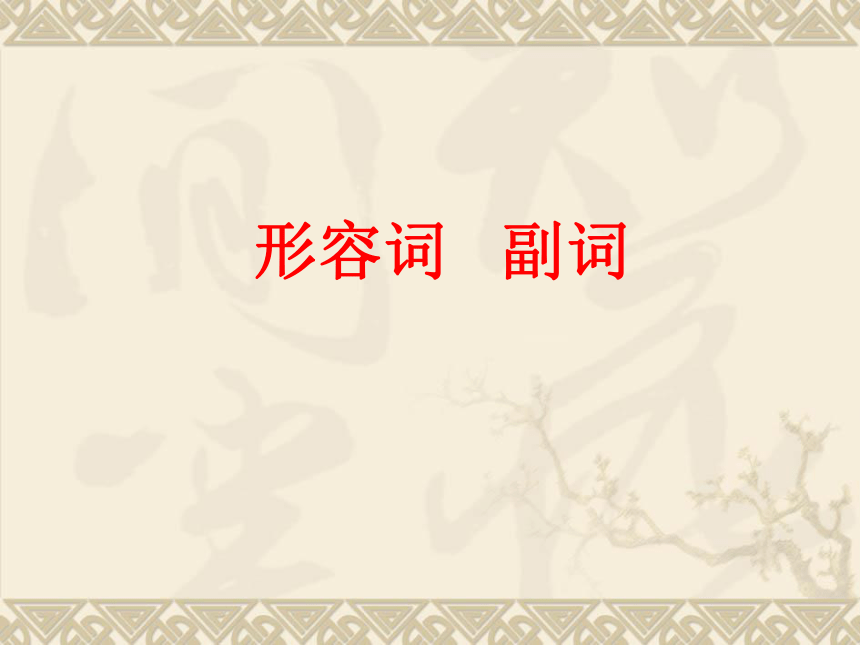 | |
| 格式 | rar | ||
| 文件大小 | 1.3MB | ||
| 资源类型 | 教案 | ||
| 版本资源 | 通用版 | ||
| 科目 | 英语 | ||
| 更新时间 | 2010-08-08 07:18:00 | ||
图片预览

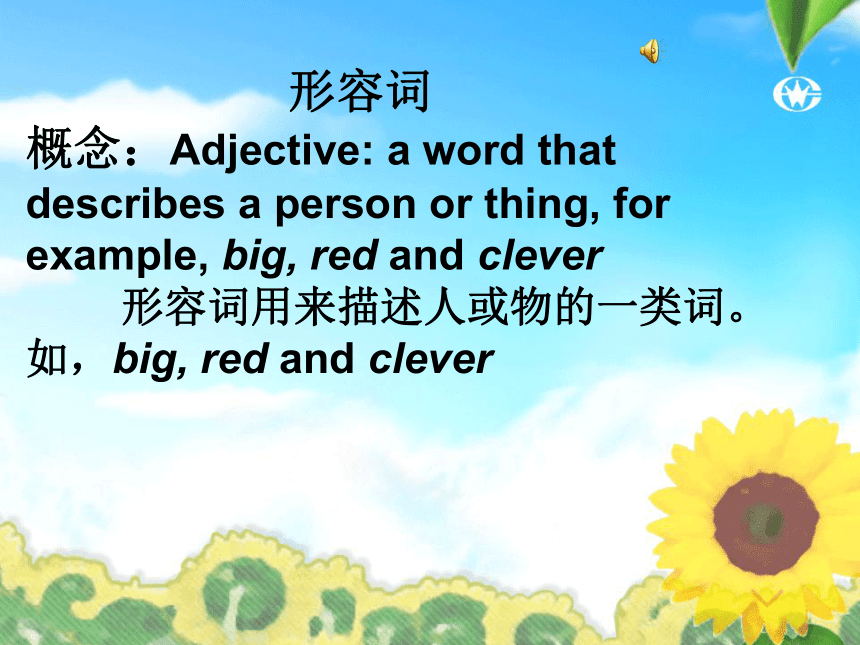

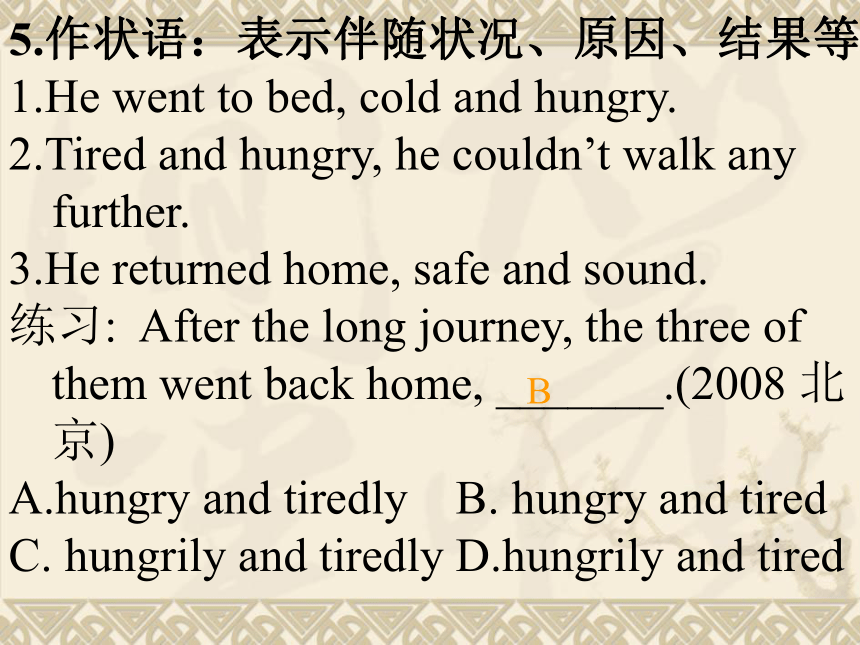
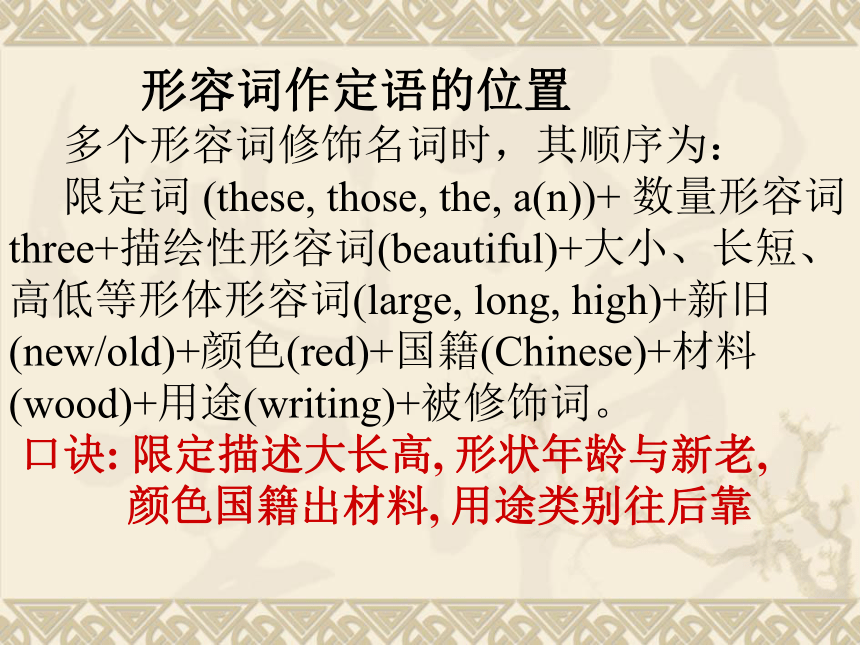

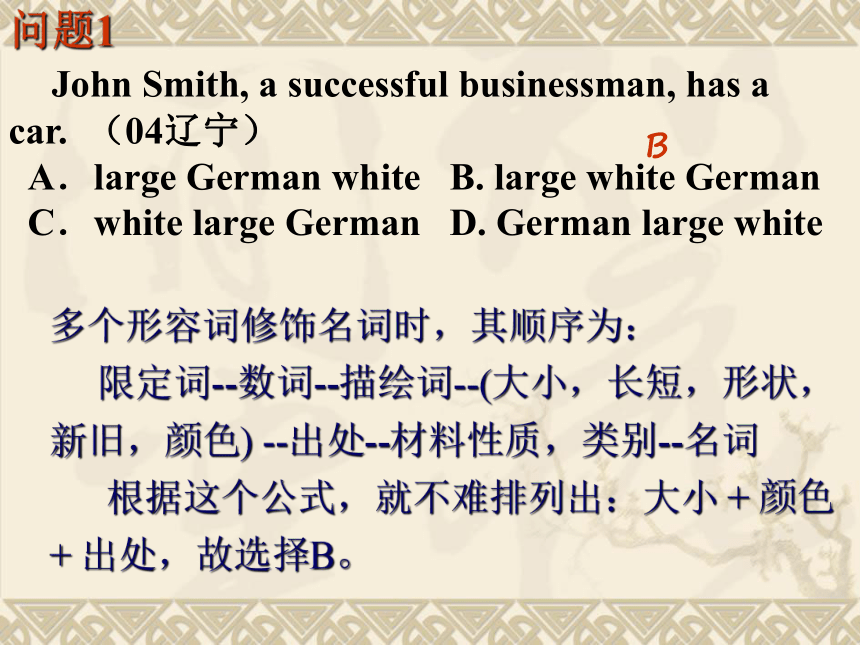
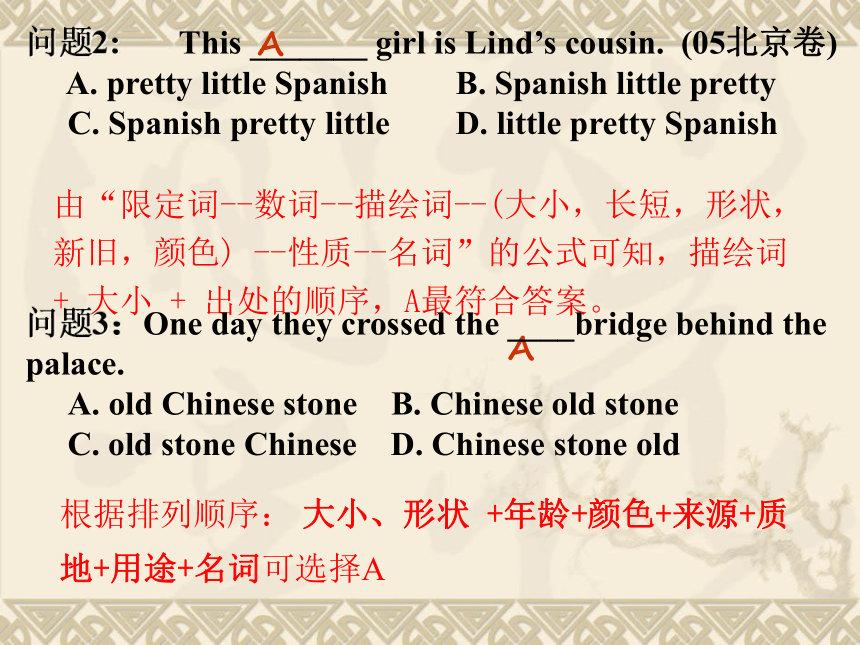
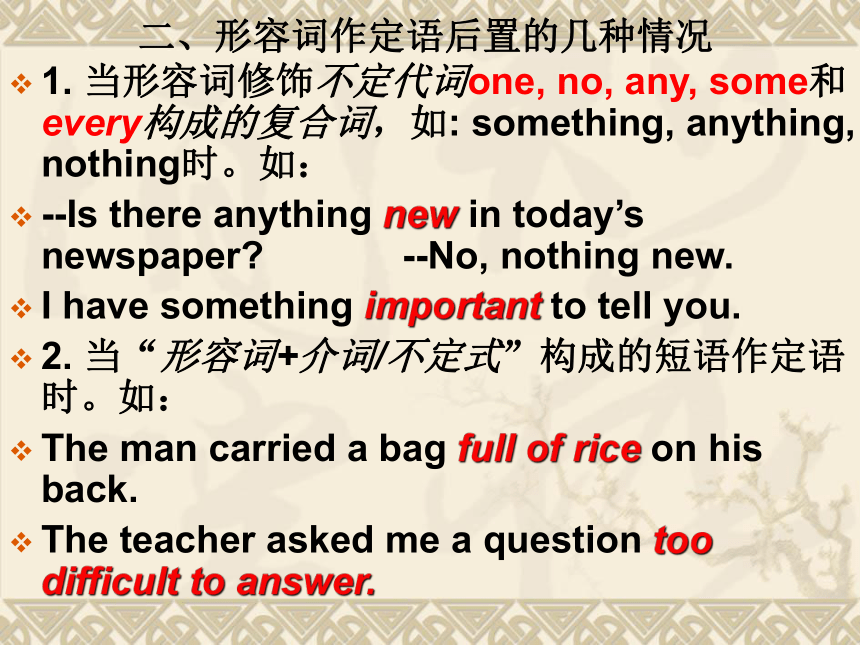
文档简介
课件24张PPT。 形容词 副词 形容词
概念:Adjective: a word that describes a person or thing, for example, big, red and clever
形容词用来描述人或物的一类词。 如,big, red and clever
下列形容词作表语时,主语通常是“事” 而不是“人”:(im)possible, (un)necessary, (im)probable, (in)convenient等。如:
It is probable that it will rain today.
It is necessary for us to meet.
It is convenient to work at the weekend. √√√√5.作状语:表示伴随状况、原因、结果等
1.He went to bed, cold and hungry.
2.Tired and hungry, he couldn’t walk any further.
3.He returned home, safe and sound.
练习: After the long journey, the three of them went back home, _______.(2008 北京)
hungry and tiredly B. hungry and tired
C. hungrily and tiredly D.hungrily and tiredB
形容词作定语的位置
多个形容词修饰名词时,其顺序为: 限定词 (these, those, the, a(n))+ 数量形容词three+描绘性形容词(beautiful)+大小、长短、高低等形体形容词(large, long, high)+新旧(new/old)+颜色(red)+国籍(Chinese)+材料(wood)+用途(writing)+被修饰词。
口诀: 限定描述大长高, 形状年龄与新老,
颜色国籍出材料, 用途类别往后靠 最近的这些日子
all these last few days
一些美丽的小红花
some beautiful little red flowers
一堵高高的红砖墙
a high red brick wall
一辆漂亮的白色的中国军用吉普车
a beautiful white Chinese military jeep( these , days , last , few , all ) ( beautiful, red, little, flowers, some )( high, a, wall, brick, red )(white, a, beautiful, Chinese, jeep, military)多个形容词修饰名词时,其顺序为: 限定词--数词--描绘词--(大小,长短,形状,新旧,颜色) --出处--材料性质,类别--名词
根据这个公式,就不难排列出:大小 + 颜色 + 出处,故选择B。B问题1
John Smith, a successful businessman, has a car. (04辽宁)
A.large German white B. large white German
C.white large German D. German large white
由“限定词--数词--描绘词--(大小,长短,形状,新旧,颜色) --性质--名词”的公式可知,描绘词 + 大小 + 出处的顺序,A最符合答案。根据排列顺序: 大小、形状 +年龄+颜色+来源+质地+用途+名词可选择AAA问题2: This _______ girl is Lind’s cousin. (05北京卷)
A. pretty little Spanish B. Spanish little pretty
C. Spanish pretty little D. little pretty Spanish
问题3:One day they crossed the ____bridge behind the palace. A. old Chinese stone B. Chinese old stone
C. old stone Chinese D. Chinese stone old
二、形容词作定语后置的几种情况1. 当形容词修饰不定代词one, no, any, some和every构成的复合词,如: something, anything, nothing时。如:
--Is there anything new in today’s newspaper? --No, nothing new.
I have something important to tell you.
2. 当“形容词+介词/不定式”构成的短语作定语时。如:
The man carried a bag full of rice on his back.
The teacher asked me a question too difficult to answer. 三、表语形容词有些形容词只作表语,而通常不作前置定语。常见的表语形容词有:afraid, awake, asleep, alive, alike, ashamed, afloat, well(healthy), sorry, unable, sure等。
如: The boy was still asleep. The old man was alone in the house.
注: ①上述形容词可以作补语。如:
We found the snake still alive.
但afraid, alive, alone, awake等可以用作后置定语.
如:He is the greatest poet alive.
He came out like a man afraid.
Tom was the only boy awake at that time.
The people, the people alone, are the motive force in the making of world history.**以字母a开头的形容词不可直接用very来修饰。非常孤单的
very much alone
熟睡的
Fast/sound asleep
十分清醒的
wide awake
很害怕的
very much afraid
非常害羞的
greatly ashamed 但当以字母a开头的形容词本身带有副词来修饰时,可以用作前置定语。如:the fast asleep boy
a somewhat afraid soldier
the wide awake soldiers英语中有些形容词既可以作前置定语,也可以作后置定语,但意义不同, 常见的有:
present(现在的/在场的),
responsible(可依赖的/应负责的),
concerned(忧心忡忡的/有关的);
proper (适当的/正经的,正式的),
involved(复杂难懂的/相关的),
absent(心不在焉的/缺席的) 可依赖的人:
应负责的人:
现在的成员:
在场的成员:
心不在焉的学生:
缺席的学生:
忧心忡忡的老师们:
(与、、、事情)有关的老师们:the responsible man the man responsible the present members the members presentthe absent students the students absent the concerned teachers the teachers concerned 副词
概念:
Adverb: a word that adds more information about place, time, manner, cause or degree to a verb, an adjective, a phrase ,another adverb or a whole sentence.
(副词是一种用来修饰动词、形容词、短语、副词或全句的词,说明时间、地点、方式、原因或程度等概念)√╳√√ 时间副词: now, then, today,
地点副词: outside, upstairs, anywhere, up,
方式副词: simply, quickly, happily, loudly,
程度副词: very, quite, rather, extremely,
频度副词:always, often, usually, seldom,
疑问副词: when, where, why, how
关系副词: when, where, why (引导定语从句)
连接副词: when, where, why,
how (引导名词性从句和副词性从句)
其他: surely, certainly, really, however, perhaps, yes, no五、两种形式的副词close接近(指距离) — closely 仔细地、密切地
free免费 — freely 自由地、自如地
deep 深 — deeply 深刻地、深入地
hard 努力地 — hardly 几乎不
wide 宽阔 — widely 广泛地
high 高 — highly 高度地
late 晚、迟 — lately 近来
near 邻近 — nearly 几乎
most 最 — mostly 主要地、绝大多数地
easy 从容地 — easily 容易地 说明:有些副词与形容词的词形完全相同。换言之,有些词同时兼有形容词和副词两种词性。
如:early, straight, slow, enough, fast, hard, long, firm, deep, wide, high, late等。
六、有些副词置于句首可修饰全句,
作评述性状语。如:
Fortunately, he was not drowned and was saved by the man.
Happily for her, her stepmother was kind to her.
Luckily, he was not hurt in the accident. 程度副词fairly/ rather/quite/pretty/very/much 的使用总结
1.fairly 修饰表示褒义的形容词或副词原级
He is fairly honest.
2.rather用以修饰一些形容词(常表示贬义)、副词的原级、比较级;rather还可以跟too连用
The book is rather too expensive.
3.quite 修饰v, 和a, ad原级,比较级和最高级
I quite agree with you. You’re quite right.
4.much 修饰v, 和a, ad的比较级、最高级
I feel much better now.
5.pretty/very 修饰a, ad,不修饰动词
It’s pretty/very good. I very like it. (X)
I much like it. (√) I quite like it.( √) enough作副词的用法
1)用来修饰形、副词时,放在所修饰词的后面 old enough
Strangely enough, some scientists have the qualities of being both careful and careless.
2)与 cannot/ can never连用,表示“再、、、也不过份”
I cannot thank you too much. = enough
You can never be careful enough in the street. (too careful)1. 用as…as…, not…as/ so…as…, the same as… such… as…引导。
亨利和彼得一样都是好工人。
Henry is a worker as good as Peter(is).
= Henry is as good a worker as Peter(is).
= Henry is such a good worker as Peter(is).
亨利的书不如我的多。
Henry does not have so/as many books as I have.
他和他父亲有同样的名字。
His name is the same as his father’s (name).
人们普遍认为,教学是一门科学,同时也是一门艺术。
It is generally believed that teaching is
as much an art as it is a science.一、平级比较
2.as+ 形容词+as 数量词=数量词+形容词。如:
The building is as tall as 100 meters.
= The building is 100 meters tall.3.倍数的表达法:
1) 倍数+比较级+than
This room is 3 times bigger than that one.
2) 倍数+ as + adj. 原级+as
This room is 4 times as big as that one.
3) the +n. + of n. 为: length, size, weight, width, height, age, number 等
This room is 4 times the size of that one.4. 貌似同等程度比较结构的一些固定习惯用语
只要,有、、、之久: as long as
到、、、地点,就、、、而言: as far as
一、、、就、、、: as soon as
既、、、又 as well as
与、、、几乎一样,几乎,简直:
as good as (=very nearly) I will work as(so) long as I live.
As far as I know, he is a reliable person.1) 他既有知识又有经验。
He has experience as well as knowledge.
2) 他就差说我是懦夫了。
He as good as called me a coward.
3) 她这人很讲信用。
She is as good as her word.
4) 他把她送到了村边的小桥那里。
He saw her off as far as the bridge near the village.
Thank you!
概念:Adjective: a word that describes a person or thing, for example, big, red and clever
形容词用来描述人或物的一类词。 如,big, red and clever
下列形容词作表语时,主语通常是“事” 而不是“人”:(im)possible, (un)necessary, (im)probable, (in)convenient等。如:
It is probable that it will rain today.
It is necessary for us to meet.
It is convenient to work at the weekend. √√√√5.作状语:表示伴随状况、原因、结果等
1.He went to bed, cold and hungry.
2.Tired and hungry, he couldn’t walk any further.
3.He returned home, safe and sound.
练习: After the long journey, the three of them went back home, _______.(2008 北京)
hungry and tiredly B. hungry and tired
C. hungrily and tiredly D.hungrily and tiredB
形容词作定语的位置
多个形容词修饰名词时,其顺序为: 限定词 (these, those, the, a(n))+ 数量形容词three+描绘性形容词(beautiful)+大小、长短、高低等形体形容词(large, long, high)+新旧(new/old)+颜色(red)+国籍(Chinese)+材料(wood)+用途(writing)+被修饰词。
口诀: 限定描述大长高, 形状年龄与新老,
颜色国籍出材料, 用途类别往后靠 最近的这些日子
all these last few days
一些美丽的小红花
some beautiful little red flowers
一堵高高的红砖墙
a high red brick wall
一辆漂亮的白色的中国军用吉普车
a beautiful white Chinese military jeep( these , days , last , few , all ) ( beautiful, red, little, flowers, some )( high, a, wall, brick, red )(white, a, beautiful, Chinese, jeep, military)多个形容词修饰名词时,其顺序为: 限定词--数词--描绘词--(大小,长短,形状,新旧,颜色) --出处--材料性质,类别--名词
根据这个公式,就不难排列出:大小 + 颜色 + 出处,故选择B。B问题1
John Smith, a successful businessman, has a car. (04辽宁)
A.large German white B. large white German
C.white large German D. German large white
由“限定词--数词--描绘词--(大小,长短,形状,新旧,颜色) --性质--名词”的公式可知,描绘词 + 大小 + 出处的顺序,A最符合答案。根据排列顺序: 大小、形状 +年龄+颜色+来源+质地+用途+名词可选择AAA问题2: This _______ girl is Lind’s cousin. (05北京卷)
A. pretty little Spanish B. Spanish little pretty
C. Spanish pretty little D. little pretty Spanish
问题3:One day they crossed the ____bridge behind the palace. A. old Chinese stone B. Chinese old stone
C. old stone Chinese D. Chinese stone old
二、形容词作定语后置的几种情况1. 当形容词修饰不定代词one, no, any, some和every构成的复合词,如: something, anything, nothing时。如:
--Is there anything new in today’s newspaper? --No, nothing new.
I have something important to tell you.
2. 当“形容词+介词/不定式”构成的短语作定语时。如:
The man carried a bag full of rice on his back.
The teacher asked me a question too difficult to answer. 三、表语形容词有些形容词只作表语,而通常不作前置定语。常见的表语形容词有:afraid, awake, asleep, alive, alike, ashamed, afloat, well(healthy), sorry, unable, sure等。
如: The boy was still asleep. The old man was alone in the house.
注: ①上述形容词可以作补语。如:
We found the snake still alive.
但afraid, alive, alone, awake等可以用作后置定语.
如:He is the greatest poet alive.
He came out like a man afraid.
Tom was the only boy awake at that time.
The people, the people alone, are the motive force in the making of world history.**以字母a开头的形容词不可直接用very来修饰。非常孤单的
very much alone
熟睡的
Fast/sound asleep
十分清醒的
wide awake
很害怕的
very much afraid
非常害羞的
greatly ashamed 但当以字母a开头的形容词本身带有副词来修饰时,可以用作前置定语。如:the fast asleep boy
a somewhat afraid soldier
the wide awake soldiers英语中有些形容词既可以作前置定语,也可以作后置定语,但意义不同, 常见的有:
present(现在的/在场的),
responsible(可依赖的/应负责的),
concerned(忧心忡忡的/有关的);
proper (适当的/正经的,正式的),
involved(复杂难懂的/相关的),
absent(心不在焉的/缺席的) 可依赖的人:
应负责的人:
现在的成员:
在场的成员:
心不在焉的学生:
缺席的学生:
忧心忡忡的老师们:
(与、、、事情)有关的老师们:the responsible man the man responsible the present members the members presentthe absent students the students absent the concerned teachers the teachers concerned 副词
概念:
Adverb: a word that adds more information about place, time, manner, cause or degree to a verb, an adjective, a phrase ,another adverb or a whole sentence.
(副词是一种用来修饰动词、形容词、短语、副词或全句的词,说明时间、地点、方式、原因或程度等概念)√╳√√ 时间副词: now, then, today,
地点副词: outside, upstairs, anywhere, up,
方式副词: simply, quickly, happily, loudly,
程度副词: very, quite, rather, extremely,
频度副词:always, often, usually, seldom,
疑问副词: when, where, why, how
关系副词: when, where, why (引导定语从句)
连接副词: when, where, why,
how (引导名词性从句和副词性从句)
其他: surely, certainly, really, however, perhaps, yes, no五、两种形式的副词close接近(指距离) — closely 仔细地、密切地
free免费 — freely 自由地、自如地
deep 深 — deeply 深刻地、深入地
hard 努力地 — hardly 几乎不
wide 宽阔 — widely 广泛地
high 高 — highly 高度地
late 晚、迟 — lately 近来
near 邻近 — nearly 几乎
most 最 — mostly 主要地、绝大多数地
easy 从容地 — easily 容易地 说明:有些副词与形容词的词形完全相同。换言之,有些词同时兼有形容词和副词两种词性。
如:early, straight, slow, enough, fast, hard, long, firm, deep, wide, high, late等。
六、有些副词置于句首可修饰全句,
作评述性状语。如:
Fortunately, he was not drowned and was saved by the man.
Happily for her, her stepmother was kind to her.
Luckily, he was not hurt in the accident. 程度副词fairly/ rather/quite/pretty/very/much 的使用总结
1.fairly 修饰表示褒义的形容词或副词原级
He is fairly honest.
2.rather用以修饰一些形容词(常表示贬义)、副词的原级、比较级;rather还可以跟too连用
The book is rather too expensive.
3.quite 修饰v, 和a, ad原级,比较级和最高级
I quite agree with you. You’re quite right.
4.much 修饰v, 和a, ad的比较级、最高级
I feel much better now.
5.pretty/very 修饰a, ad,不修饰动词
It’s pretty/very good. I very like it. (X)
I much like it. (√) I quite like it.( √) enough作副词的用法
1)用来修饰形、副词时,放在所修饰词的后面 old enough
Strangely enough, some scientists have the qualities of being both careful and careless.
2)与 cannot/ can never连用,表示“再、、、也不过份”
I cannot thank you too much. = enough
You can never be careful enough in the street. (too careful)1. 用as…as…, not…as/ so…as…, the same as… such… as…引导。
亨利和彼得一样都是好工人。
Henry is a worker as good as Peter(is).
= Henry is as good a worker as Peter(is).
= Henry is such a good worker as Peter(is).
亨利的书不如我的多。
Henry does not have so/as many books as I have.
他和他父亲有同样的名字。
His name is the same as his father’s (name).
人们普遍认为,教学是一门科学,同时也是一门艺术。
It is generally believed that teaching is
as much an art as it is a science.一、平级比较
2.as+ 形容词+as 数量词=数量词+形容词。如:
The building is as tall as 100 meters.
= The building is 100 meters tall.3.倍数的表达法:
1) 倍数+比较级+than
This room is 3 times bigger than that one.
2) 倍数+ as + adj. 原级+as
This room is 4 times as big as that one.
3) the +n. + of n. 为: length, size, weight, width, height, age, number 等
This room is 4 times the size of that one.4. 貌似同等程度比较结构的一些固定习惯用语
只要,有、、、之久: as long as
到、、、地点,就、、、而言: as far as
一、、、就、、、: as soon as
既、、、又 as well as
与、、、几乎一样,几乎,简直:
as good as (=very nearly) I will work as(so) long as I live.
As far as I know, he is a reliable person.1) 他既有知识又有经验。
He has experience as well as knowledge.
2) 他就差说我是懦夫了。
He as good as called me a coward.
3) 她这人很讲信用。
She is as good as her word.
4) 他把她送到了村边的小桥那里。
He saw her off as far as the bridge near the village.
Thank you!
